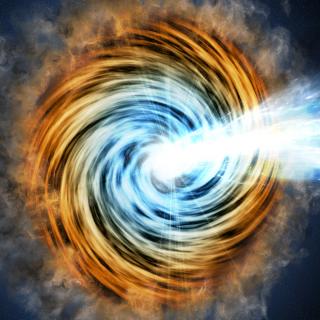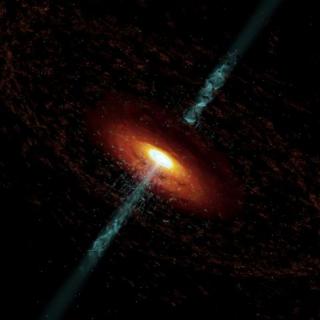The international collaboration Whole Earth Blazar Telescope (WEBT), in which researchers from the Instituto de Astrofísica de Canarias (IAC) participate, has discovered rapid and quasi-periodic variations in the observed brightness of the blazar BL Lacertae, located about a billion light-years away. These changes were observed during a strong outburst in 2020 and their origin is associated with a jet of high-energy particles. The study has used data from space satellites combined with observations from ground-based infrastructures, including the Teide Observatory (OT) and the Roque de los Muchachos Observatory (ORM). The results are published in the prestigious journal Nature.
A blazar is a type of active galactic nucleus (AGN) that is powered by material falling into a supermassive black hole at the center of a galaxy. About 10% of AGNs have a pair of jets that are propelled into interstellar space at near-light speeds. Blazars occur when one of the jets points almost directly toward Earth, which makes it appear much brighter because of a beaming effect. The phenomenon is similar to what happens with the light from a lighthouse.
The jets produce an emission of electromagnetic radiation that changes rapidly with time, ranging from radio waves to gamma rays. Those changes are usually random, with no discernable pattern, it is therefore necessary to observe these sources frequently. For more than 10 years, teams, such as the international collaboration Whole Earth Blazar Telescope (WEBT) - INAF/Osservatorio Astrofisico di Torino and the Astrophysics group at Boston University (USA), have been monitoring with ground-based telescopes a sample of gamma-ray-bright blazars, which are also observed by the AGILE (Italian Space Agency) and Fermi (NASA) satellites.
In a recent study, the WEBT collaboration has monitored the variability of visible light in the blazar BL Lacertae (BL Lac) during a strong multi-wavelength outburst in the second half of 2020. The observations uncovered cycles of very fast visible brightness changes, oscillating approximately every 13 hours, and maintained for a month. BL Lac is powered by a black hole of 170 million solar masses and is located about 1 billion light-years away.
The cycles of brightness changes are termed “quasi-periodic oscillations (QPOs). “QPOs are more often seen in other systems called X-ray black hole binaries, which have black holes with smaller masses, between 10 and 50 solar masses, and are generally explained by clumps of hot gas in the disk of accreting material orbiting the black hole,” says Svetlana Jorstad of Boston University, who led the team of astronomers participating in the study published in Nature. “However, in the case of BL Lac, the light is polarized, which is not the case for emission by hot gas in the disk, so that interpreting such behavior is difficult,” she indicates.
Kinks in the jet's magnetic field
The team has proposed that a kink forms in the jet, twisting the magnetic field in such a way that it causes the brightness to oscillate. Furthermore, the polarization changes with similar timescale as the brightness. ‘’Such polarized light comes from the jet, and the polarization can vary only if the magnetic field changes in the light-producing region. The magnetic field in the jet must be twisting in order to cause the oscillations,’’ explains Alan Marscher of Boston University and a co-author in the study.
“If the magnetic field in a jet has a spiral pattern, the jet and field can become unstable and twist, creating a kink. As the particles in the jet flow through the kink, the amount of beaming changes back and forth, which causes the QPOs," explains Haocheng Zhang from NASA’s Goddard Space Flight Center and a co-author in the study.
In determining the origin of gamma rays in blazars, simultaneous monitoring in visible light from ground-based observatories and at high energies from satellites is very important. The joint participation of a network of telescopes located in different parts of the Earth has been essential. The research has used observations from 37 different telescopes, including several of those located at the Teide Observatory (OT) and the Roque de los Muchachos Observatory (ORM). "In the case of BL Lac, it has been observed that there is no delay between the variations observed in gamma and visible rays, which indicates that both emissions come from the same area of the jet," says José Antonio Acosta Pulido, a researcher at the IAC who participated in the study,
Artículo: S. Jorstad, et al: “Rapid Quasi-Periodic Oscillations in the relativistic jet of the blazar BL Lacertae”, Nature, 8 September 2022. DOI: https://www.nature.com/articles/s41586-022-05038-9
Contacto en el IAC:
José Antonio Acosta Pulido, jose.acosta [at] iac.es (jose[dot]acosta[at]iac[dot]es)






